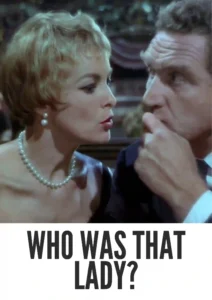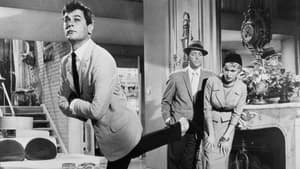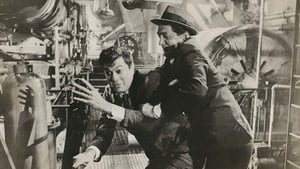Video Sources 0 Views

Synopsis

Step back into the era of Cold War jitters and comedic brilliance with Who Was That Lady?, a delightful romp from 1960, now brilliantly colorized to tickle your funny bone. This film, featuring the comedic talents of Tony Curtis and Dean Martin, delivers a hilarious blend of mistaken identities, marital misunderstandings, and espionage spoofs. Perfect for fans of classic comedies and those seeking a lighthearted escape, this HD download brings a sparkling piece of cinematic history to your screen. Some regions may also know this film as “A Very Important Person.”
Who Was That Lady? spins the tale of David Williams (Tony Curtis), a college professor, and his best friend, Michael Haney (Dean Martin), a television writer. David finds himself in hot water when one of his students, after an innocent goodbye kiss, is caught by his suspicious wife, Ann (Janet Leigh). To avoid a domestic disaster, Michael concocts a wild story that David is secretly working for the FBI and that the kiss was part of an undercover operation.
The situation spirals out of control when the FBI, and eventually the Soviets, get involved, leading to a series of hilarious misunderstandings and close calls. David and Michael must navigate a world of spies, double agents, and seductive women, all while trying to keep their wives from discovering the truth. The film is a whirlwind of comedic situations, showcasing the duo’s impeccable timing and charm. Ultimately, Who Was That Lady? is a laugh-out-loud comedy that pokes fun at the Cold War paranoia and celebrates the bonds of friendship.
The film boasts a stellar cast of comedic actors who bring this madcap story to life:
-
Tony Curtis as David Williams
-
Dean Martin as Michael Haney
-
Janet Leigh as Ann Williams
-
James Whitmore as Harry Powell
-
Dick Shawn as Parker
Who Was That Lady? firmly sits in the genre of Cold War comedy, blending elements of screwball antics, romantic entanglements, and satirical espionage. Its witty dialogue, farcical situations, and the undeniable chemistry between Curtis and Martin make it a standout in the comedy world.
Released in 1960, Who Was That Lady? reflects the anxieties and absurdities of the Cold War era through a comedic lens. The film was produced during a time when tensions between the United States and the Soviet Union were high, and the threat of nuclear war loomed large. By satirizing the espionage genre and poking fun at government agencies, Who Was That Lady? offered audiences a much-needed dose of comedic relief. The film’s success reflects the public’s appetite for entertainment that both acknowledged and lightened the atmosphere of the Cold War.
This colorized version of Who Was That Lady? has been painstakingly restored, using cutting-edge digital technology to breathe new life into the classic comedy. The colorization process involved a meticulous frame-by-frame analysis of the original black and white footage, with expert colorists carefully selecting hues that enhance the visual appeal while respecting the film’s original aesthetic. Sophisticated algorithms were employed to ensure accurate color representation and seamless integration, resulting in a vibrant and immersive viewing experience. While debates about colorizing classic films continue, this restoration introduces Who Was That Lady? to a wider audience, ensuring its longevity for generations to come.
-
: George Sidney
-
: Norman Krasna
-
: the play “Who Was That Lady I Saw You With?” by Norman Krasna
-
: Harry Stradling Sr.
-
: Viola Lawrence
-
: Ansark-Sidney Productions
-
: Columbia Pictures
-
: 115 minutes
-
: MP4
-
: HD (1080p)
-
: Compatible with most devices, including smartphones, tablets, computers, and smart TVs.
Who Was That Lady? (1960) is celebrated for its witty script, fast-paced direction, and the undeniable chemistry between Tony Curtis and Dean Martin. The film was a box office success upon its release and continues to be enjoyed by audiences today. Its clever satire of Cold War espionage and its timeless humor have solidified its place as a classic of the comedy genre. A must-see for fans of classic comedies and those seeking a lighthearted escape.
-
: What is Who Was That Lady? about?
-
A: Who Was That Lady? is a Cold War comedy about a college professor who pretends to be an FBI agent to cover up an innocent kiss, leading to a series of hilarious misunderstandings.
-
-
: Is Who Was That Lady? (1960) a well-known Tony Curtis and Dean Martin film?
-
A: Who Was That Lady? is a popular and well-regarded film starring Tony Curtis and Dean Martin, known for its comedic brilliance and satirical take on the Cold War.
-
-
: Is this version of Who Was That Lady? colorized?
-
A: Yes, this version has been professionally colorized to enhance the viewing experience.
-
-
: What makes Who Was That Lady? interesting for comedy fans?
-
A: Who Was That Lady? is a prime example of Cold War comedy, featuring witty dialogue, farcical situations, and the comedic genius of Tony Curtis and Dean Martin.
-
-
: What is the download format?
-
A: The download format is MP4, which is compatible with most devices.
-
-
: What resolution is the download?
-
A: The resolution is HD (1080p), providing a high-quality viewing experience.
-
Laugh with Who Was That Lady? Today!












